A collection full of evil
Type: Singleplayer, Multiplayer
Genre: Strategy
Developer: Realmforge Studios
Publisher: Kalypso Media
Release date: 26 Jun, 2020


The Dungeons series got its start back in 2011, with the release of Dungeons, a weird game that looked like Dungeon Keeper at first glance, but was more akin to Theme Park. Dungeons 2 went back to the drawing board, and made a game that mixed the dungeon building of Dungeon Keeper, with a more traditional RTS, with the underground sections giving you more indirect control of things, and the overworld allowing you to control your creatures directly. Dungeons 3 then expanded and refined this further.
Dungeons 3 was first released in 2017, and over the years a number of DLCs have been released for it. 7 to be more precise, as well as a soundtrack. Dungeons 3 – Complete Collection is, as the name implies, a complete collection of all these DLCs. That’s the base game, 6 story DLCs new campaigns, as well as one that gives you more skirmish maps, and of course the above mentioned soundtrack.
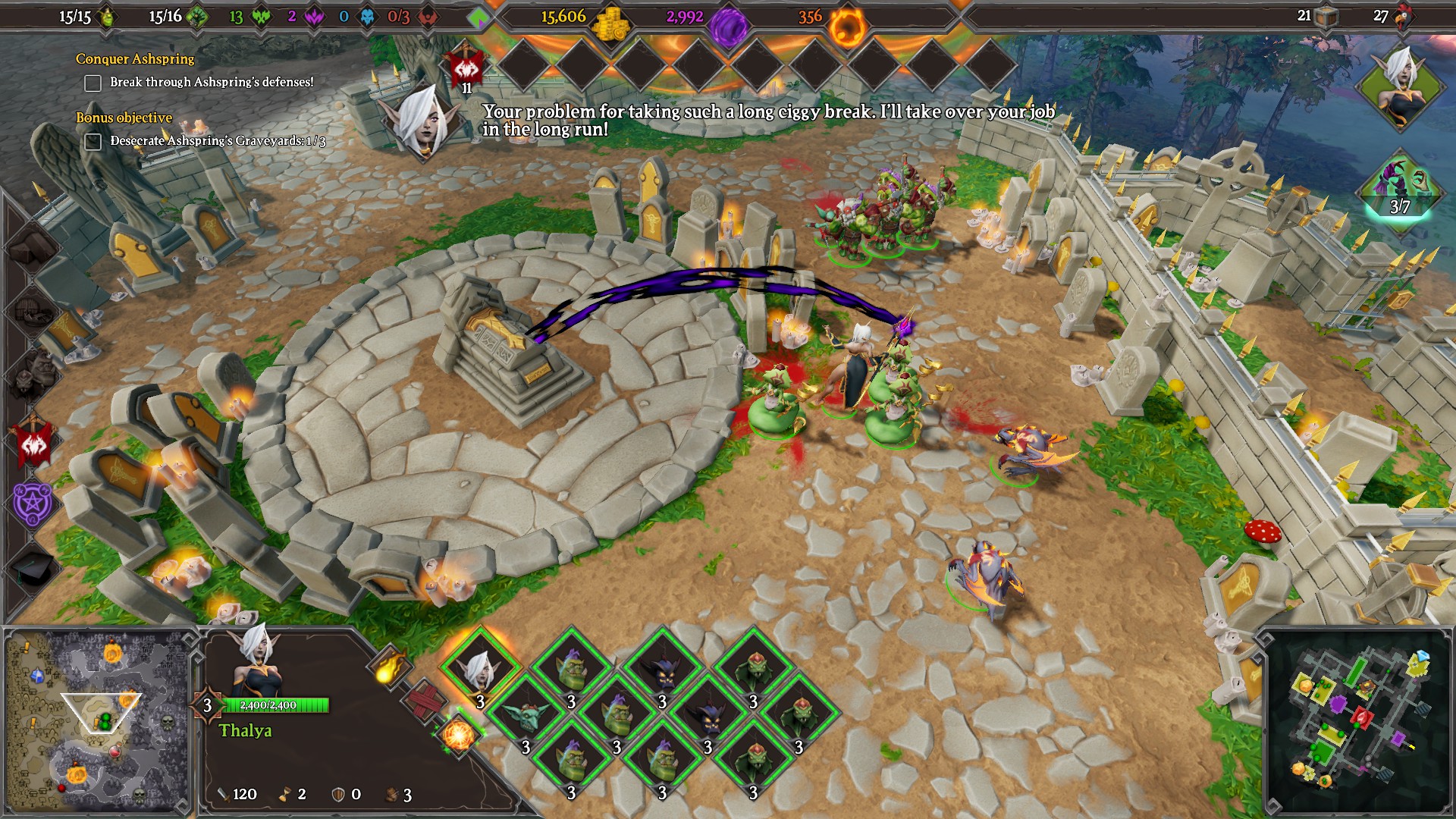
Story & Setting
The conquering Evil had defeated all that was good in the land, and was now getting bored. There was no innocent people to oppress, no villages to burn down, and no rare creatures to hunt to extinction. Basically, life as an evil lord is no fun when you’ve got nobody left to be evil to. So the particularly crafty Evil decides to do the only logical thing, and go across the sea to conquer new lands. That ends up being a disaster, as evil creatures are better at building traps and torture devices than ships.
After a few failed attempts at building a fleet, the manipulative Evil realizes that his evil minions are useless, and decides to go about things another way. He’ll find someone who can serve him in this far away land. And he finds just the right person for that, a dark elf named Thalya, who’s been raised by the sickeningly good paladin Tanos.
Shocked by the sudden turn to evil of Thalya, and her murdering a whole lot of innocent bystanders, Tanos sets out to try and redeem his foster daughter. Of course, the conniving Evil has no intentions on letting his new servant fall to the forces of good, and so the story begins, with you controlling the forces of evil, lead by Thalya, as they fight against the forces of good, with Tanos and his companions trying to stop you from destroying the land.
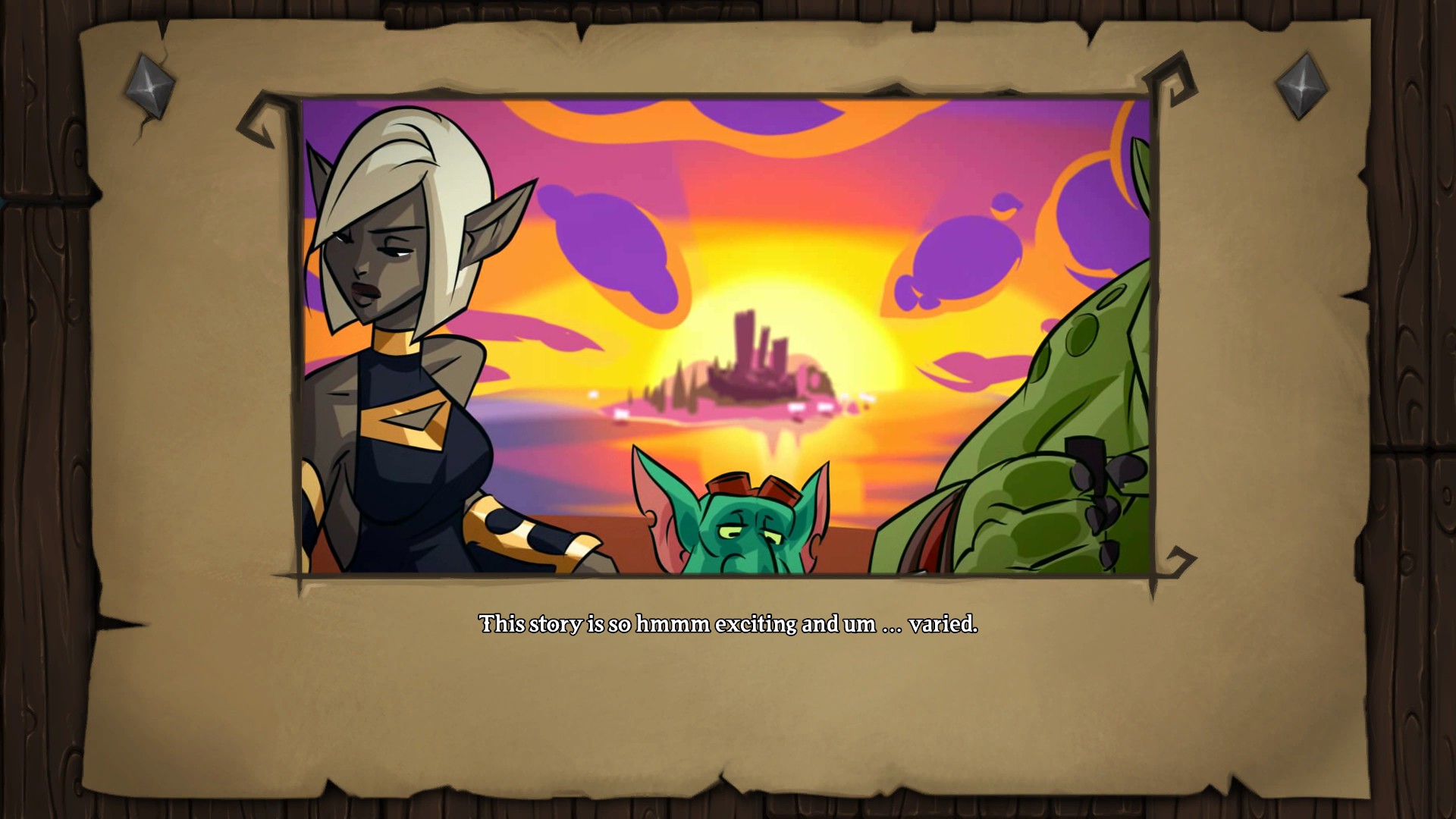
Dungeons 3 is, at its heart, a comedy game. Evil is never portrayed in a very dark or serious way. Sure, you might pillage, murder and/or torture, but it’s all played for laughs. You never get to really see the negative consequences of your actions, and that’s fully intentional, this is not a game that tries to explore any deeper meanings of evil, it just lets you cause havoc and destruction in an overly cheerful land, and see people get killed in a very bloodless way.
Most of the humor in Dungeons 3 is referential. Sometimes it falls into a simple “look, we took this name from Warcraft, and changed it a little bit so it sounds like something else!”, and sometimes the jokes build upon a reference, but someone who’s not familiar with at least a few of the big fantasy series, be it books, movies or games, like Warcraft, Lord of the Rings, Conan and so on, will probably find most of the jokes to be little more than gibberish. And the setting is, for the most part, little more than an extension of these referential jokes.
Through the entire game you have a narrator who comments on what’s going on, and who often breaks the 4th wall (and bickers with Thalya). The narrator is the source of most of the games jokes, and there are a remarkable amount of voice lines recorded for him. It also directly influences the world, the narrator can act as a bit like a grumpy GM in a roleplaying game, and summon random monsters when it feels like it. This is the kind of narrator that some people are likely to find very entertaining, while others just want him to shut up.
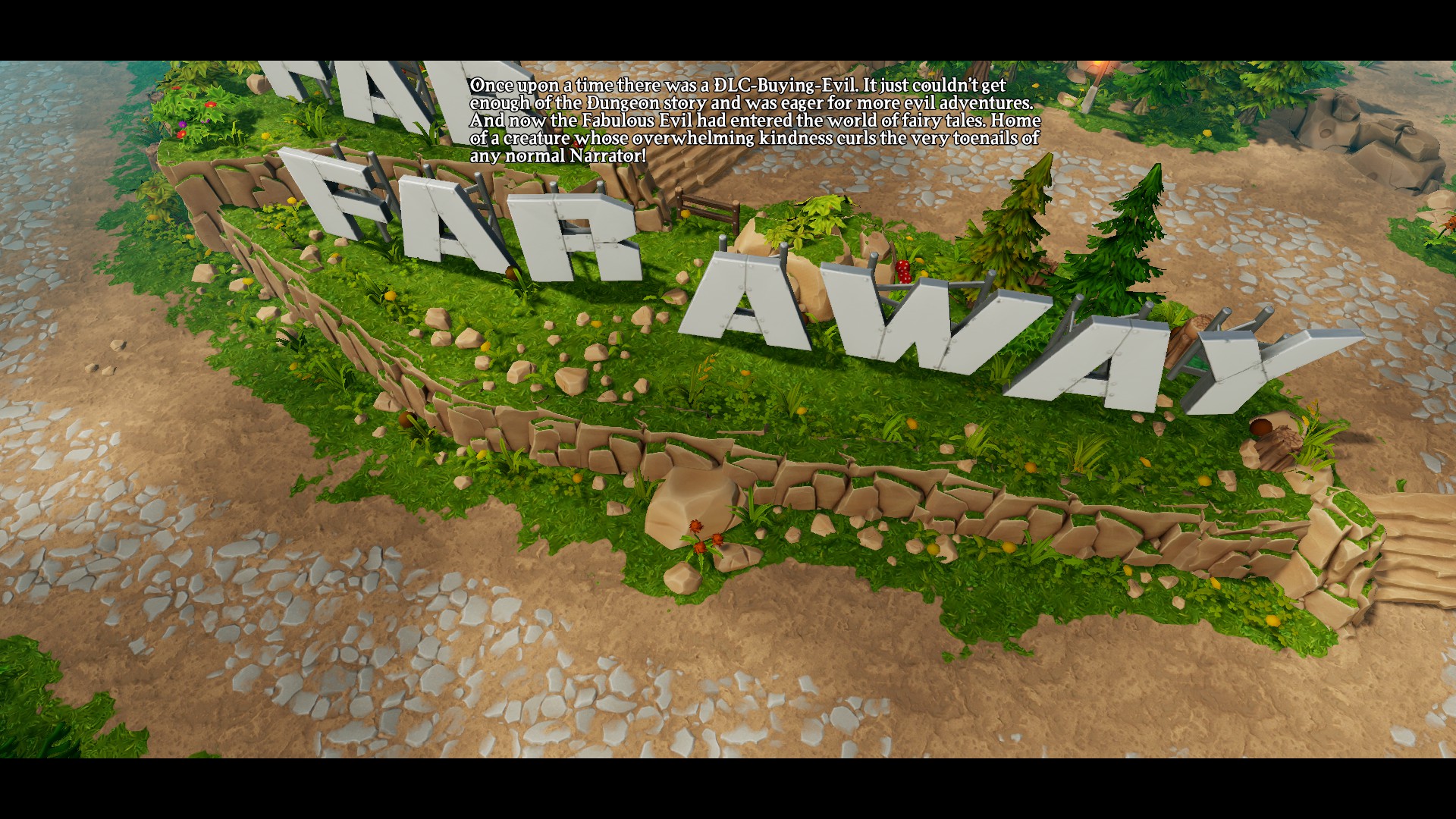
Presentation
Dungeons 3 has graphics that matches its tone, that’s to stay it’s stylized and a bit cartoonish looking. The game uses bright and bold colours, and the character models, as well as a lot of the objects in the world, has exaggerated traits. This gives it a look that’s a bit akin to Warcraft 3 or World of Warcraft. It’s a nice look, and it’s quite good at hiding the fact that many of the models are not very detailed.
Sadly the games cutscenes give a somewhat cheap impression. They’re not very smoothly animated, and you can often easily tell where the “joints” are in the characters. Had the game tried to go with a serious tone, then the cutscenes would have been a problem, but now they’re at least easy to ignore.
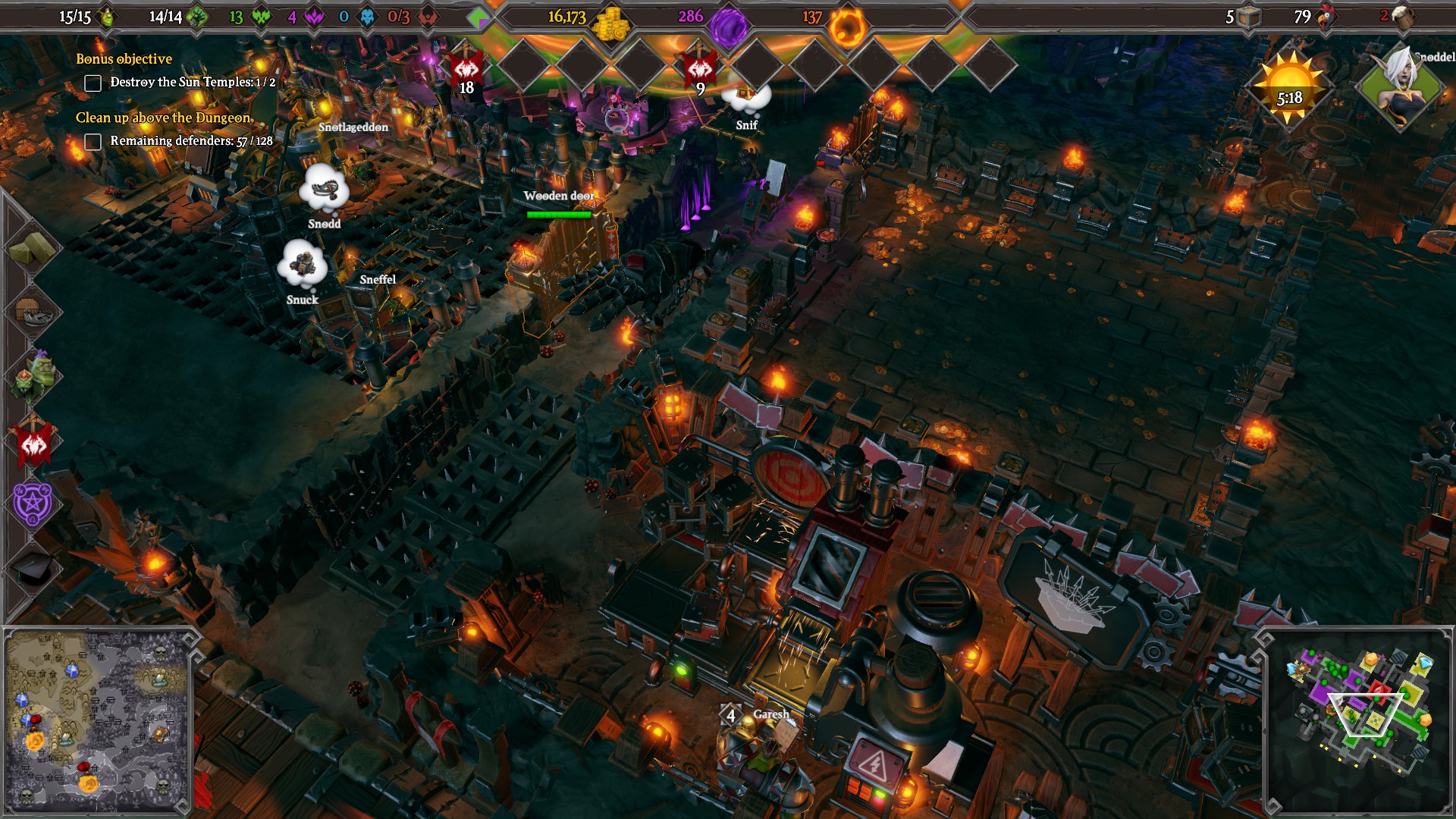
The game has a pleasant enough soundtrack, which seems to draw inspiration from a wide number of sources, like the Lord of the Rings and Harry Potter movies. It fits well, and the music will change on the fly when you move from regions controlled by the forces of good, and the forces of evil. The transition between the songs is smooth, and the songs are similar enough that it does not become jarring when you switch between good and evil regions.
Many of the games sound effects feel a bit lacking. When there’s fighting, you can hear creatures hit each other, but there’s not much beyond that, creatures don’t call out in unique ways, and combat just sounds a bit tame. There are other things around the world that also make their own sound effects, and these fare better than the combat sound.
There are a lot of lines read out by a few voice actors in Dungeons 3, in fact, there’s nearly a constant barrage of it, most of which comes from the narrator or Thalya, with some other key characters getting their own voice actors, and some minor characters get a few voice lines. The voice acting is in general pretty good at least, and adds to the overall experience.
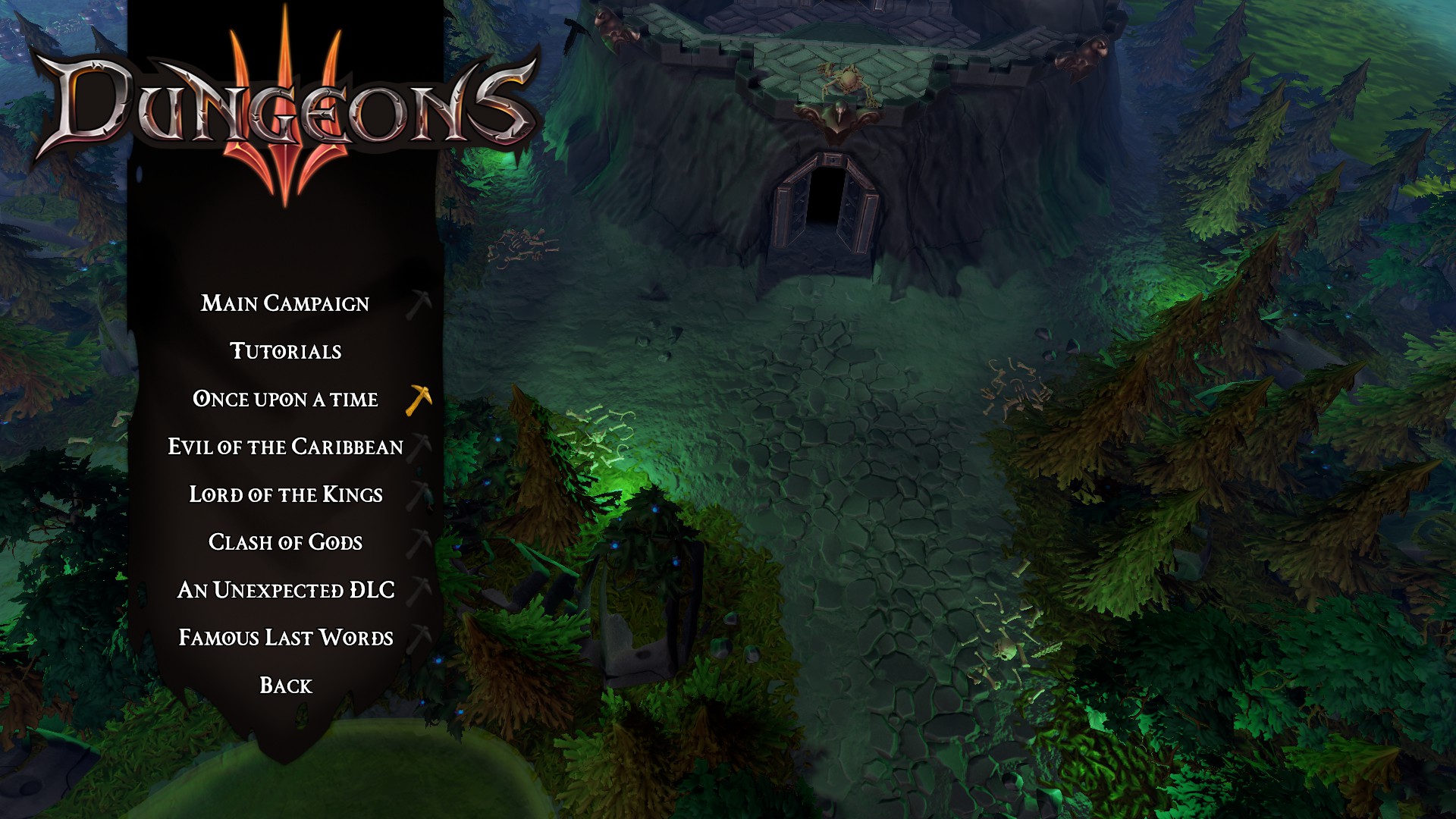
Gameplay
At first glance, Dungeons 3 looks like it would be very similar to Dungeon Keeper or War for the Overworld, but in practice, it’s a very different game.
Dungeons 3 can basically be split into two separate parts, the overworld and underworld stuff. In the underworld you build your own base, and collect resources, and here you can’t directly control your units, while in the overworld you’re taking the fight to the enemy, and try to control your creatures just like you would in a normal RTS.
The underworld segments play like a simplified Dungeon Keeper. Here is where your dungeon heart is, and if it ever gets destroyed, you lose. You’ve got a handful of workers, small creatures known as snots, who diligently do what they’re told to do. If you tell them to dig somewhere, they dig, if the square they dig out has gold then they’ll take that to the treasury, if you build a room, they’ll go and complete the construction. You don’t need to assign individual snots to do any particular task, they’ll figure it out on their own, although if you absolutely need to get something done fast, you can pick one up and drop it on what you want them to work on. This hands off approach works quite well, as your attention will usually be elsewhere.
Snots won’t win you the game on their own though, you need fighters. This is where your other creatures come in. Creatures come in three different categories, with three normal creatures and one really strong creature each, horde (like orcs), daemon and undead, and each category have their own wants and needs. The undead needs graveyards to sleep in and once they start getting a bit stronger, a temple, while horde creatures want a lair, and beer. Each category of creatures also have something they can do in the dungeon, daemons can generate mana, horde creatures make traps and undead can revive fallen creatures, if you build the right rooms for them.
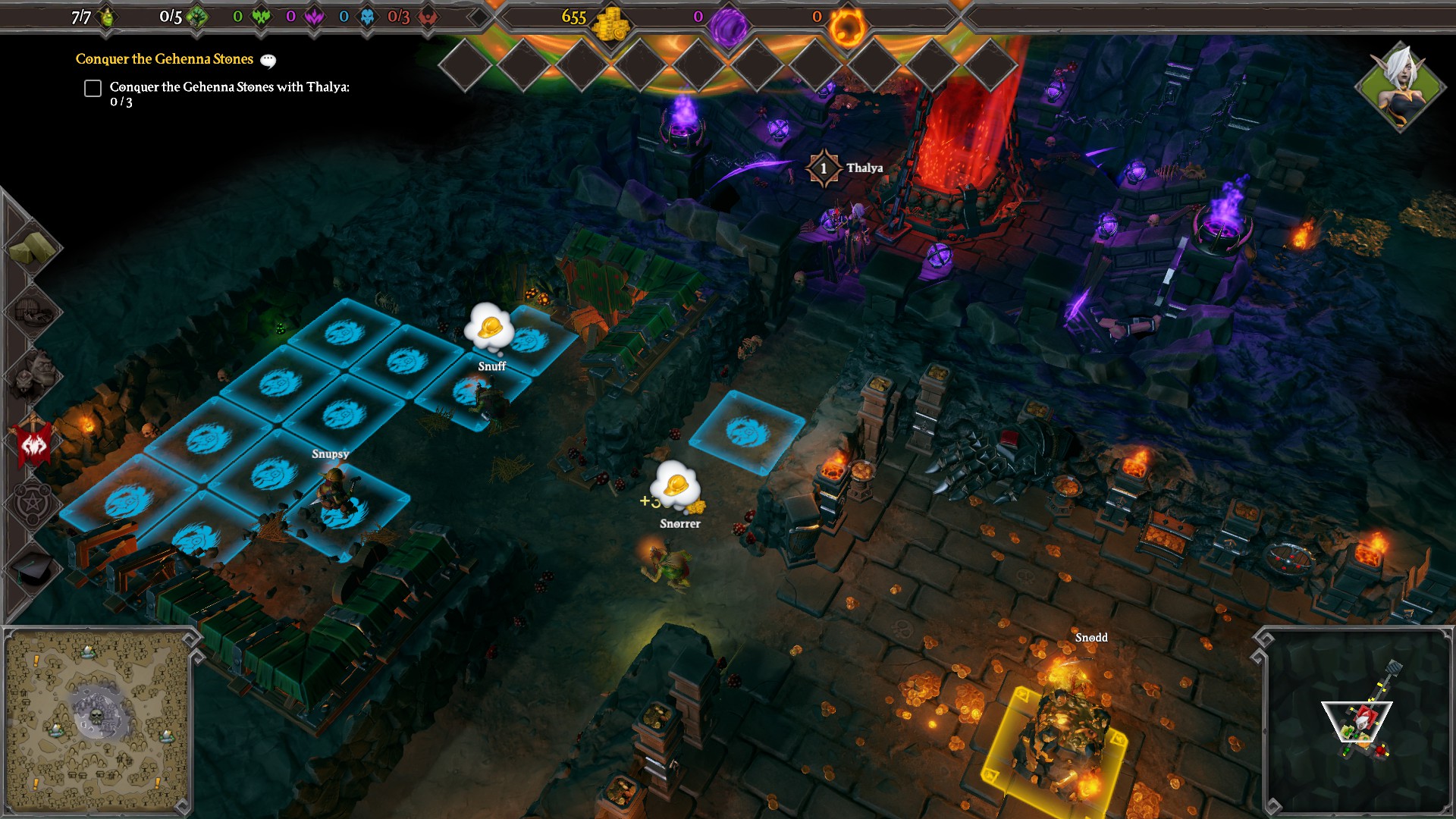
Building things is simple. You mark an area for excavation in the underworld, and your snots will quickly dig it out. Then you just build a room there. There’s some strategy to room placement though, rooms are most efficient when they’re surrounded by walls, and every opening lowers the efficiency, but just having a bunch of rooms that don’t connect makes movement through the dungeon less efficient. Also, you can’t place traps in rooms, so if your strategy is built around those, then you want to make sure that any invading good guys have to walk through long and painful corridors before they can reach the populated part of your dungeon.
In the overworld things change dramatically. You can pick up your creatures and drop them into any exit, and they’ll appear outside the corresponding entrance on the overworld map. Here you can control them directly. Here you’ll find bands of good guys loitering in the streets, just waiting to pick a fight with your evil creatures, as well as two special types of “buildings”. The first one is nice places that you can convert to evil (by killing all good guys who stand nearby). These usually look like particularly good places (and are clearly marked on the map). Once converted, they’ll start generating evilness, basically research points, for you. The other are buildings that heroes spawn from. These heroes will, once spawned, either try to make their way to your dungeon, or reclaim spots that you’ve corrupted to evil.
Taking care of your creatures is very important. They’ll level up and grow more powerful over time. Horde creatures can, until you’ve built the right undead building, die permanently, while undead and daemons are effectively immortal, although having them die on you while out on the field can still be a setback, and reviving them and bringing them back to full strength is still a bit of a hassle. Your creatures will get unhappy and refuse to work if you don’t provide them with what they want, so if you can’t pay them on payday, they’ll get grumpy and then finally go on strike.
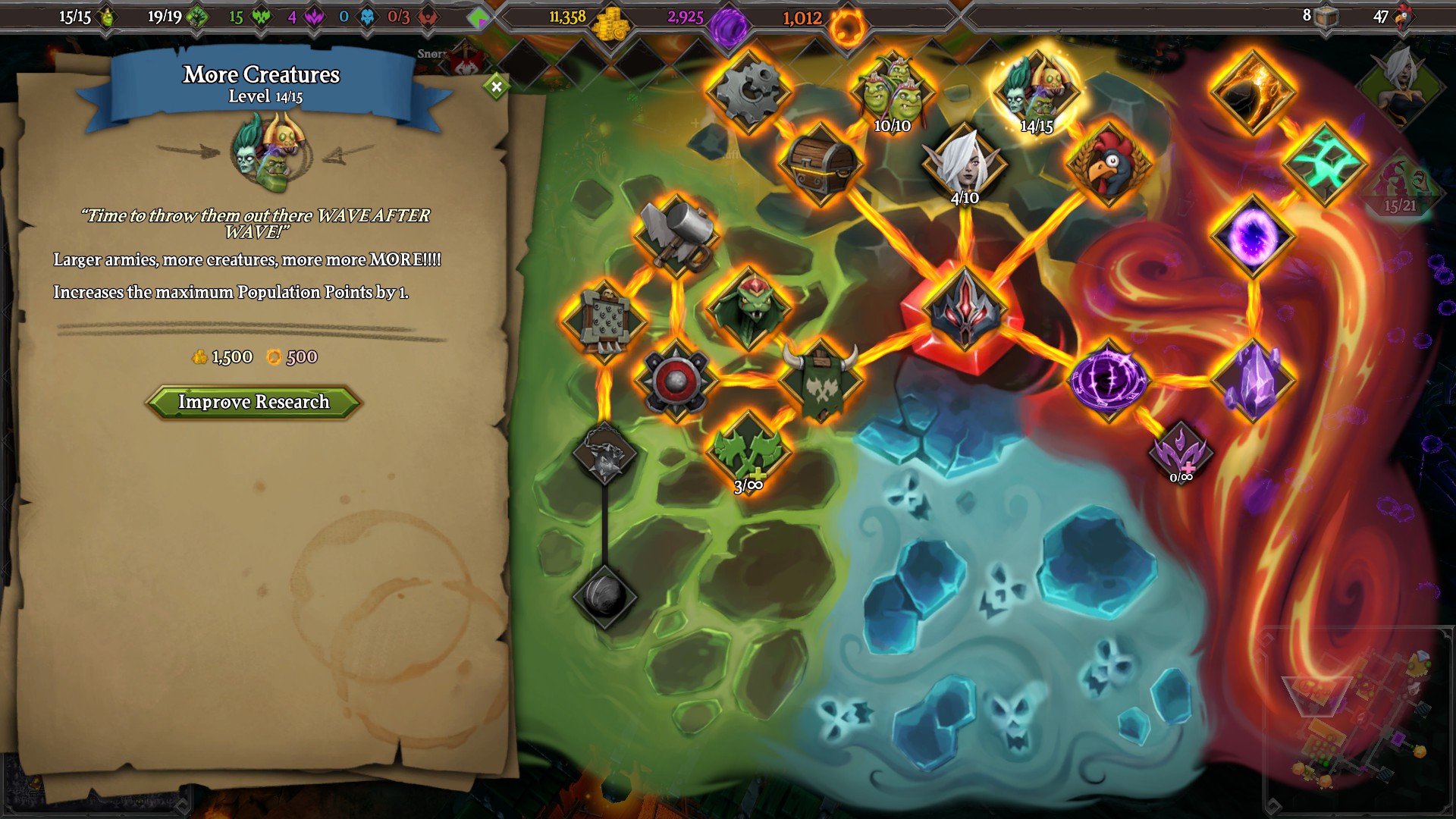
Research is generated passively, from each node you’ve conquered in the overworld, and is used to unlock more room types, creature types, spells and with a lecture hall you can also improve existing creatures and rooms, as well as unlock even more spells.
Dungeons 3 has a substantial campaign, which can be played in co-op. It does a great job at giving you new toys to play with right up until the end, which most levels giving you access to more rooms, creature types and/or spells. Almost every level also has some kind of unique mechanic, that makes it play differently from any other level. Some levels are so focused around their gimmicks that it takes away from any real strategy, but the variety is there.
This is carried over to the DLC, with most levels having level gimmicks, some small and some big. The DLC levels are also generally speaking a bit harder than those in the core game. They don’t radically alter the core of the game, but are still different enough that the game does not get stale. The DLC also introduces new good guys to fight, but don’t do much to change up the evil side.
On top of the singleplayer and co-op, there’s also competitive multiplayer. Sadly I could not find a match for the purposes of this review.
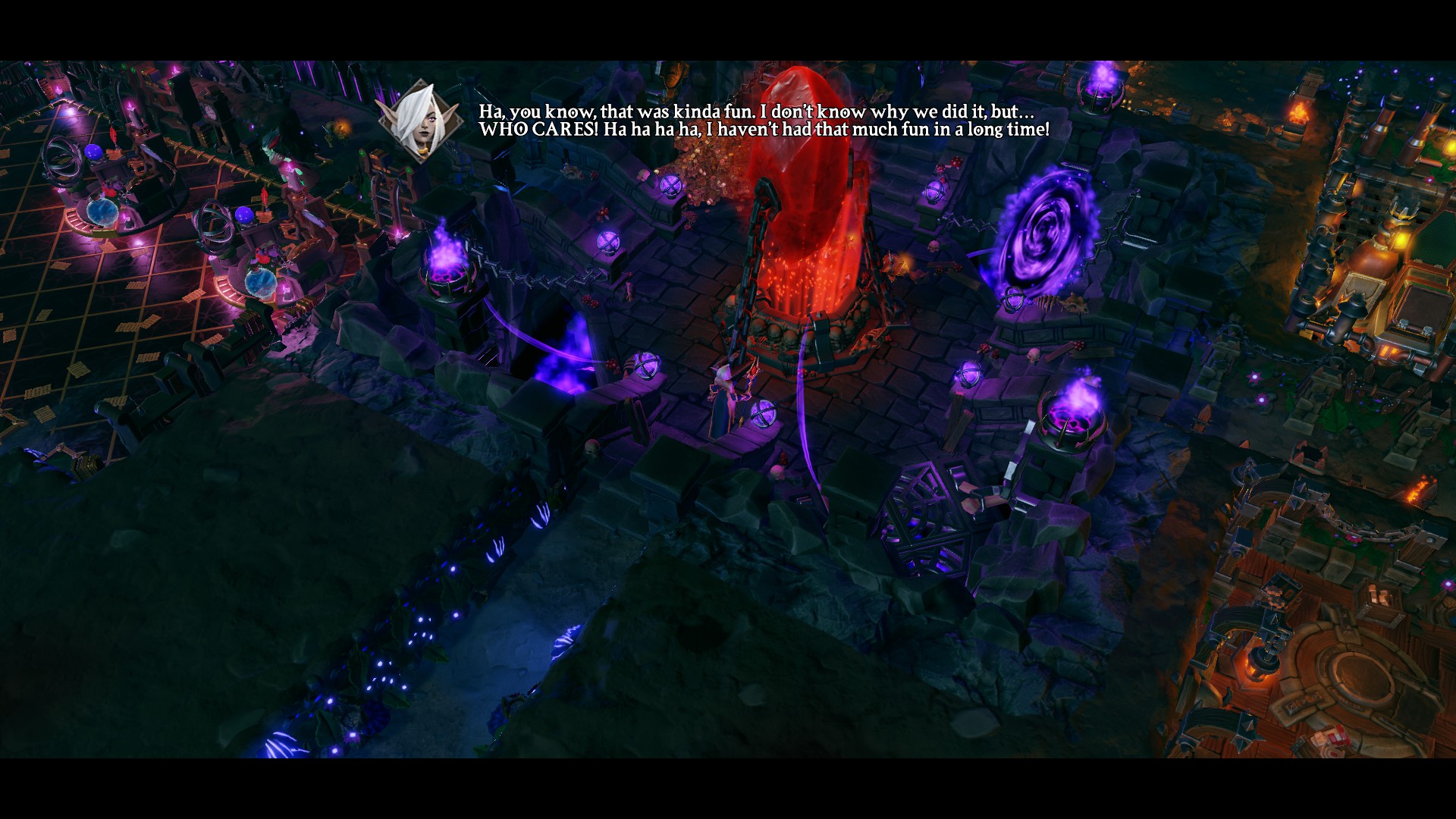
Closing Thoughts
There’s no denying that you get a lot of game for your money with Dungeons 3 – Complete Collection. Between the base game’s already substantial 20 level campaign, and the over 20 new campaign levels from the DLCs, this won’t be a game anyone beats in an evening.
But just being very long is not enough to make a game good. Luckily Dungeons 3 is both fun to play, and varied enough to justify its length. Its variety does come at a cost though, having the game split up between two distinct sections (over and underworld) with very different gameplay means that neither got as much development time and care as they would if they had just gone with one of the two. Thus the underworld segments feel a bit simplistic compared to Dungeon Keeper and War for the Overworld, and at the same time, the overworld section does not require as nuanced tactics as it would in a dedicated real time tactics game. Also, with so many levels having their own unique mechanics, you often have somewhat under-developed mechanics. So Dungeons 3 is really a jack of all trades-master of none game.
Dungeons 3 is ultimately a very fun game though. Just don’t go in thinking it’s Dungeon Keeper with a new coat of paint, the Dungeons series is at this point its own thing, and there’s nothing else quite like it on the market. If you already own the base game, then it won’t make much sense to buy the complete collection, just buy the missing DLC, but if you don’t own Dungeons 3, and you’re interested in it, then the Complete Collection is a no-brainer.










